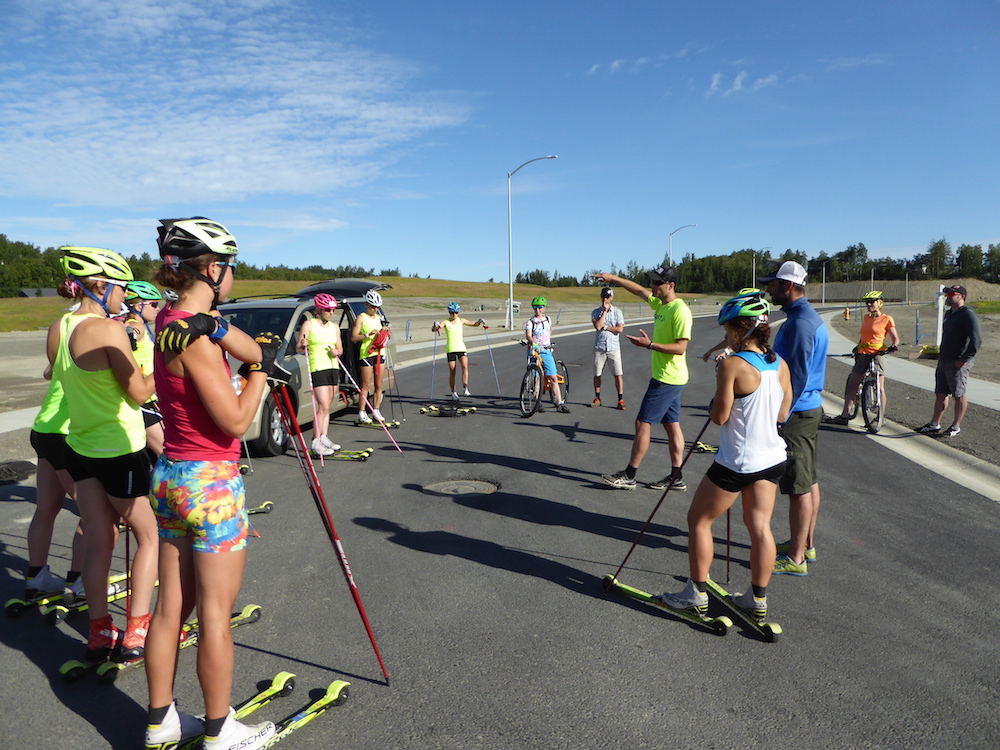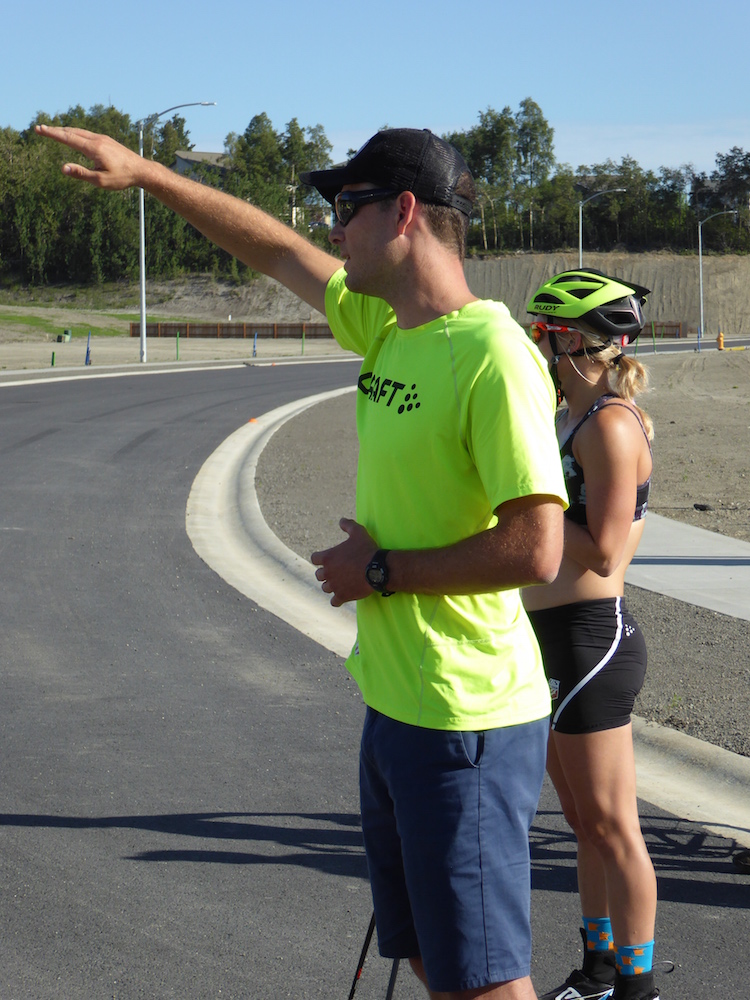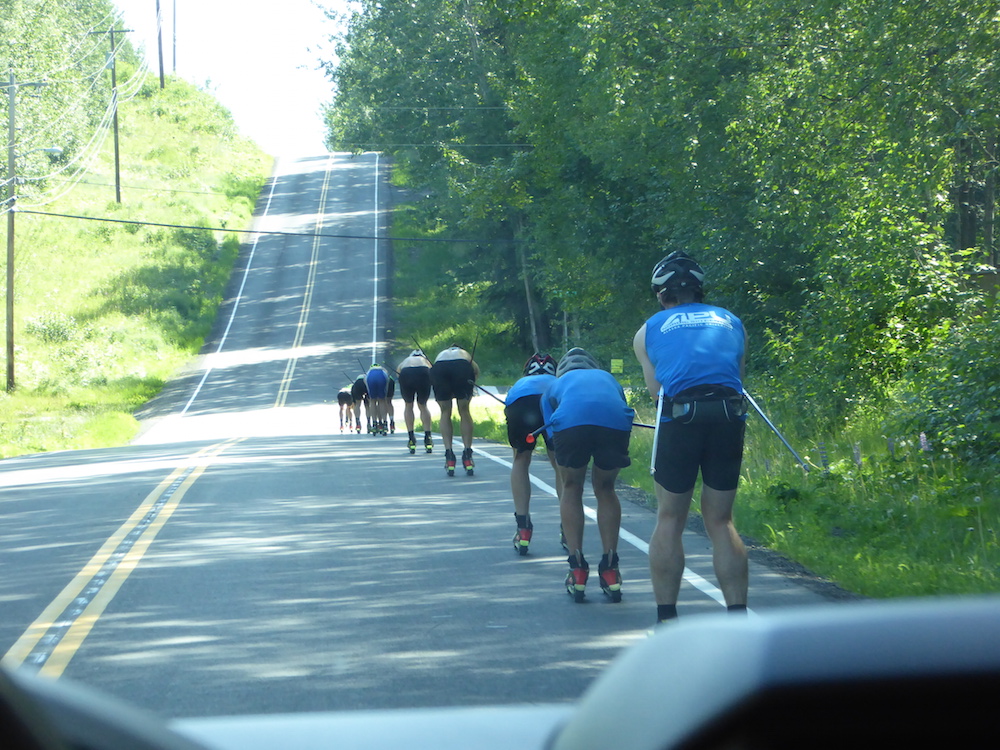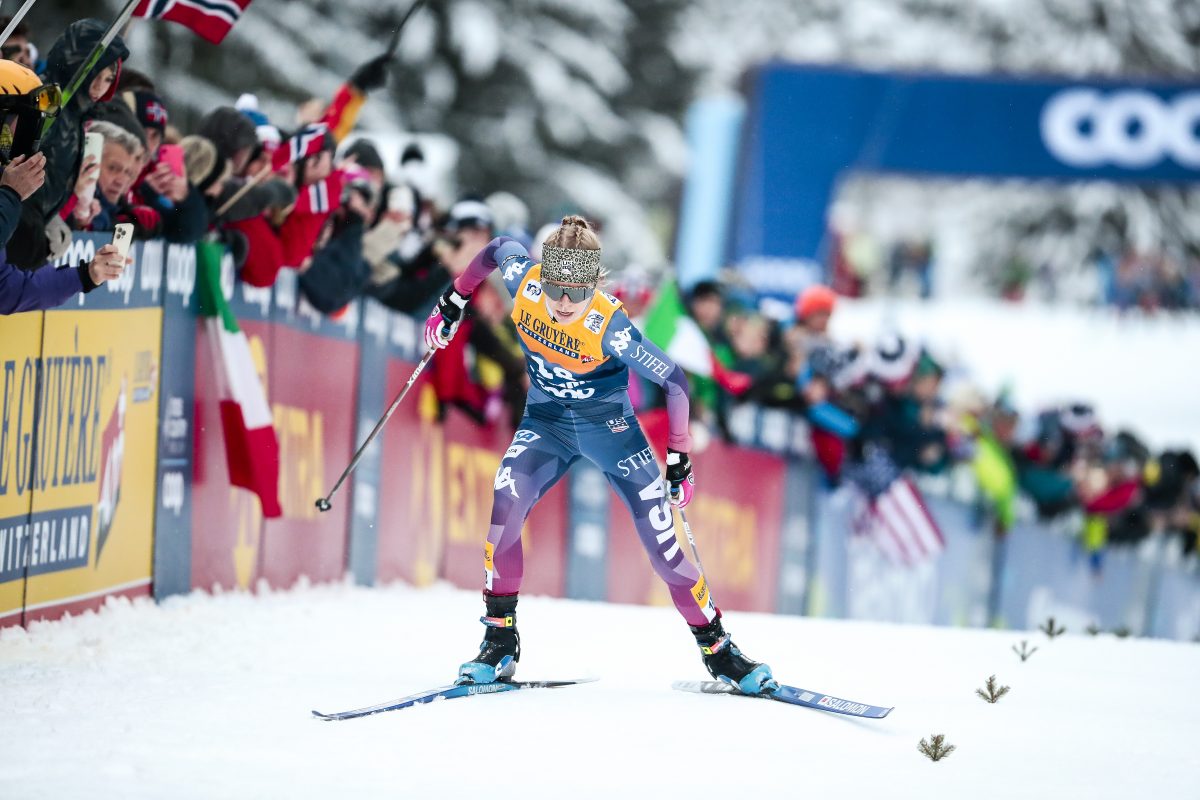
ANCHORAGE, Alaska — Earlier this month, the U.S. Ski Team and its coaches came to Alaska for a two-week training camp, starting with one week of dryland training and then one week on snow at Eagle Glacier. Before heading up to the glacier, FasterSkier caught up with U.S. Ski Team (USST) Women’s Coach Matt Whitcomb for a brief in-person interview about the national team and their World Championships aspirations following a rollerski workout during the first half of camp.
FasterSkier: So this is a World Championships year. I know that U.S. Ski Team Head Coach Chris Grover previously told FasterSkier that an announced program goal is two medals in Lahti. Do you have anything to add to that, and can you speak to some of the races where the team might be expecting success?

Matt Whitcomb: You know, all of our planning in the spring revolves around winning medals at the major championships of the year. So without overemphasizing our goals, we have in place what we feel are two realistic goals of two medals. We are more than happy to walk away with five. We will be disappointed with less [than two]. So we feel like, as a program, we are good enough so that two medals is an appropriate reach, and in many events, we have opportunities.
Our highest strike rates for medal opportunities are certainly in both sprints [Note: Whitcomb clarified to explain he meant both genders in men’s and women’s team and individual sprints] as well as in the women’s 4 x 5 [kilometer] relay, but you also have the women’s 30 k, the women’s skiathlon, and we’re happy to be surprised in any of the other events.
FS: You mentioned the skiathlon – from a domestic perspective, did you notice that there is going to be a skiathlon in the SuperTour this year [to be hosted by the Fairbanks Nordic Ski Club during Spring Series], and what role does that have for athlete development in this country?
MW: [laughs] Leave it to John Estle [of Fairbanks] to be able to organize one of the more high-maintenance events. But in no way am I surprised; we’re just very thankful. It’s often that at the junior and even U23 level when we go internationally, that we’re scrambling last-minute to find skiathlon boots, or to teach athletes how to load an exchange zone and what the rules are. So we’ll consider this just a quick dose of education for our entire community, and I think it’s going to have a big effect. It’s going to be a really fun event – not for his volunteers, but we thank them.
FS: Jessie Diggins spent a week in Norway in June at a Norwegian national team training camp. What does that say not only about Jessie as a skier, but also about the strength of this program?
MW: Yeah, it’s a good question. First and foremost, not anybody is going to be accepted to a Norwegian camp, and that’s to really understate that. Jessie’s season and her attitude and her overall personality have a lot to do with it. So the first credit goes to her.
But the next credit goes to, really, Norway. On the back of their old waxing bus, it says, “Sharing the knowledge and the experience” – that’s what they put right on their most prominent vehicle. And they have become such a huge asset to our program. Their coaches are our friends; we know all their athletes; they’re friends with our athletes; we interface at the World Cup. And they truly do want to help us. And so when we asked if Jessie could join a camp, they said, “let me talk with the girls” – make sure their team was okay with it – and then got back to us with some options. And we were so impressed by it.
But I think it’s also a strong testament to our nation, and our program as a good partner to Norway as well. We’ve had Astrid [Jacobsen] at a camp, we’ve had Celine [Brun-Lie] at camps – we are happy to help in any way we can while on the World Cup.
Granted, a program like Norway needs very little. But it’s a multi-tiered reason that this is something that’s possible, that’s put a guy like [Andy] Newell in Norway right now, training with top-level athletes, and has put Liz [Stephen] and Kikkan [Randall] at multiple Norwegian National Team camps, where their coaches are spending time out of their day to discuss video with our athletes. It’s invaluable for us.
And I should say that Jessie had a phenomenal experience.

FS: We can feel like we generally know what to expect by now from the veteran women’s team members. What can you tell us about the three youngest members of the team: Hannah Halvorsen, Katharine Ogden and Julia Kern?
MW: Really exciting to have a new member of our D-team this year in Hannah Halvorsen out of Truckee, California. We’ve begun working with her coach, Martin Benes, and their program [Sugar Bowl Academy] more closely in the last year or two and are very impressed with them. So that’s exciting to have some input from California these days.
She’s a bright girl, she’s funny, she loves team, she’s very quickly friends with everybody on the team. And she’s going to really complete this sort of what is a D-team squad now, with KO [Katharine Ogden], Julia [Kern], and Hannah, as well as Ian Torchia. So that’s really exciting.
And with those three women, we can expect anything from podiums at World Juniors to something in the twenties or thirties could even be considered a solid race. We’re not looking to rush any results out of these women. What we’ve told them and their programs, their club programs, is that we want to exercise extreme patience. We have high confidence that these three athletes are some of the emerging stars that we feel like can mature into very successful World Cup athletes. And if that means having success at World Juniors, that’s great, U23s, that’s great, but we want it ultimately to be that these three women fill some of the shoes that will eventually retire.
FS: With regard to other specific athletes, can you say anything about what it’s meant to have Kikkan back with the team?
MW: It’s been so great to have Kikkan’s energy back and physical presence. In many ways, it just never left. She took some time out for pregnancy, and now we’re meeting her baby at an actual camp, and she’s training with us again. And it has just injected everybody with a high dose of energy again, so that’s really fun.
To have Hannah join us at the lower ranks of the team, and Kikkan return at the upper end, has just created a great bookend for us to launch this season.
FS: Chris Grover recently explained that the World Champs selection criteria have been changed. I think it’s a fair summary to say that skiing well in Period 4 of last season is no longer as important, and that skiing well in Period 1 of this season is now more important. Accepting that premise for the moment, do you see that affecting your athletes’ preparation? How do you think the athletes feel about that – maybe especially the athletes on the bubble either way?
MW: It’s definitely a criterion that focuses more on how athletes are skiing closer to the Championships. It’s a very important concept, I think, that from what I can tell the entire ski community is behind.
From a World Cup perspective, we have a couple different options. Athletes can race through Period 1, and they need to be within a certain standard on the World Cup. [For objective criteria: either a top-eight result in most of the individual races from Period 1, the Tour de Ski or the sprint weekend following the Tour de Ski, or a top-50 ranking in either the Sprint or Distance standings on Jan. 16, 2017.] And if they are close to but not in that going into the Tour de Ski, they need to make a pretty important decision. And that is whether or not to go back to U.S. championships and qualify domestically, or to take a chance and go with what they know and qualify in the Tour de Ski, and the sprint weekend after the Tour de Ski in Toblach. And so there are a great number of options both domestically and internationally on the World Cup, that I think we feel is as fair as can be.
FS: Is it fair to say that making discretionary picks is one of the harder parts of your job as a coach?
MW: For sure. We love not to do it. But in any criteria, discretion can often be one of the most important pieces. We really envy these Olympic Trials [for American track and field athletes for the 2016 Rio Olympics] that we’re watching right now, where the top three go and fourth is either an alternate or they don’t go, and it’s just much more objective.
FS: You’ve been very gracious with your time – anything else you want to add or wish I’d asked before we wrap up?
MW: With athletes training over 800 and 900 hours a year, we have good confidence that we’re training as well and in some cases better than our competitors who are best in the world. The trick is to differentiate our training from our competitors’, and to make our 900 hours more effective than their 900 hours. And our team over the last several years has begun working more and more closely with individual sports psychologists as well as individual club coaches and national team coaches to become the mentally toughest team on the World Cup. And that is something we work hard to be. It is something that we feel can differentiate our 900 hours or our 800 hours from their 900 or 800.
Gavin Kentch
Gavin Kentch wrote for FasterSkier from 2016–2022. He has a cat named Marit.



